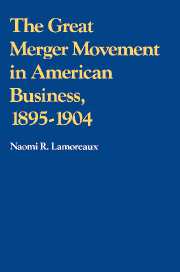Book contents
- Frontmatter
- Contents
- Acknowledgments
- List of tables and figures
- 1 Introduction
- 2 Product differentiation, mass production, and the urge to merge: competitive strategies and collusion in the late nineteenth century
- 3 High fixed costs and rapid expansion: a model of price warfare and two examples
- 4 Quantitative and qualitative evidence on the great merger movement
- 5 What changed? The impact of consolidations on competitive behavior
- 6 The great merger movement and antitrust policy
- 7 Conclusion
- Bibliographical essay
- Index
6 - The great merger movement and antitrust policy
Published online by Cambridge University Press: 01 April 2010
- Frontmatter
- Contents
- Acknowledgments
- List of tables and figures
- 1 Introduction
- 2 Product differentiation, mass production, and the urge to merge: competitive strategies and collusion in the late nineteenth century
- 3 High fixed costs and rapid expansion: a model of price warfare and two examples
- 4 Quantitative and qualitative evidence on the great merger movement
- 5 What changed? The impact of consolidations on competitive behavior
- 6 The great merger movement and antitrust policy
- 7 Conclusion
- Bibliographical essay
- Index
Summary
To a people preternaturally sensitive to the dangers of monopoly, the great merger movement came as a shock. Americans had watched with foreboding the formation of Standard Oil, the first “trust,” and with increasing anxiety the imitations that Standard's success spawned in industries as diverse as sugar refining and lead processing. Then, as the merger movement crested, with hundreds of firms vanishing suddenly into horizontal consolidations, it seemed as if the United States had been transformed overnight from a nation of freely competing, individually owned enterprises into a nation dominated by a small number of giant corporations. Very quickly Americans thought they saw their worst fears about such domination confirmed, as consolidations jacked up prices and at the same time moved to secure their monopoly positions by extracting rebates from railroads and restricting competitors’ access to raw materials and markets.
As the public outcry mounted, politicians launched investigations at many different levels and in several branches of government. President Theodore Roosevelt resuscitated the Sherman Antitrust Act with his successful prosecution of the Northern Securities holding company in 1904. He and his successor, William Howard Taft, initiated a series of dissolution suits against major consolidations, including Standard Oil, U.S. Steel, and the American Tobacco Company. Finally, under the administration of Woodrow Wilson, Congress supplemented and strengthened the Sherman Act with the passage of the Federal Trade Commission Act and Clayton Antitrust Act in 1914.
Prompt federal action seems to have helped assuage the public's fear and outrage. But whether or not it also protected the competitive structure of American industry has recently been the subject of much debate.
- Type
- Chapter
- Information
- The Great Merger Movement in American Business, 1895–1904 , pp. 159 - 186Publisher: Cambridge University PressPrint publication year: 1985
- 2
- Cited by



